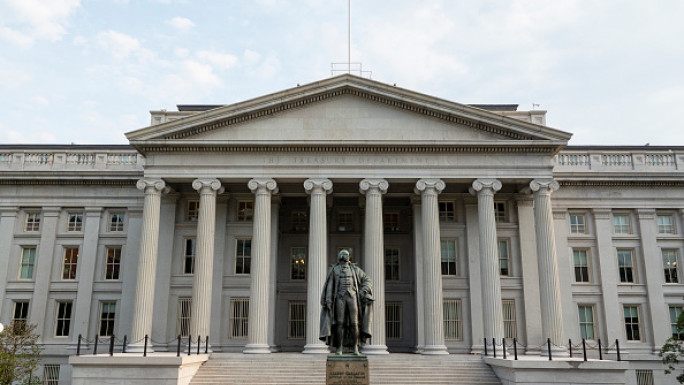Oman to see fastest economic growth in MENA region in 2022, according to World Bank
Oman to see fastest economic growth in MENA region in 2022, according to World Bank
Oman is set to be one of the countries to see the swiftest economic recovery from the Covid-19 epidemic.
3 min read
Oman could see nearly 8 percent economic growth in 2022 [Getty]
Oman is set for the fastest economic growth in the Middle East North Africa (MENA) region next year, according to the World Bank, with the sultanate predicted to overcome several challenges such as current low oil prices and the Covid-19 epidemic.
Oman's real GDP growth at market prices is estimated to stand at 7.9 percent in 2022, according to the study, putting the sultanate ahead of 15 other countries in the region surveyed in the study.
In the Gulf region, Kuwait is set to see 3.1 percent growth, Qatar 3 percent, Bahrain 2.5 percent, the UAE 2.4 percent, and Saudi Arabia 2.2 percent, according to the report.
It marks a remarkable turnaround for Oman, which the World Bank predicted will see a 9.4 percent economic contraction in 2020 and just 0.5 percent growth in 2021.
Oman's recovery will be in part due to estimated higher oil prices, which are projected to rise to $50 a barrel in 2022, according to the World Bank report.
Conrad Prabhu, writing for the Oman Observer, noted that the sultanate's high economic growth could also be down to the government economic plans for the coming years.
"A cornerstone of Oman's efforts to turn around the economy is the Medium Term Fiscal Balance Plan, a landmark blueprint adopted by the government to strike a balance between revenue and expenditures over the 2020 – 2024 timeframe," he wrote.
Iraq, another oil producer with diversification plans, is also estimated to see a surge in economic activity in 2022 with 7.3 percent growth, according to the study.
Globally, the fastest economic recovery will be seen in Niger with 11.7 percent growth, the Maldives at 11.5 percent, and Ethiopia with 8.7 per cent.
The World Bank report noted the huge hit countries in the Middle East have taken from the Covid-19 epidemic, which has affected most economic sectors from tourism to oil.
"The COVID-19 pandemic has caused deep output losses, on the order of 5.0 percent in 2020, in the Middle East and North Africa (MENA)," it read.
Iran, Jordan, Tunisia, and Algeria are estimated to see the slowest growth in 2022 with at 1.7, 2, 2, and 2.1 percent respectively.
Oman has seen major constitutional changes this week, with the announcement of a crown prince position for the first time in the sultanate's history.
Sultan Haitham bin Tariq Al-Said - who became ruler in January 2020 - named his eldest son, Dhi Yazan bin Haitham, as his heir, among changes to the Basic Law announced this week.
Oman's real GDP growth at market prices is estimated to stand at 7.9 percent in 2022, according to the study, putting the sultanate ahead of 15 other countries in the region surveyed in the study.
In the Gulf region, Kuwait is set to see 3.1 percent growth, Qatar 3 percent, Bahrain 2.5 percent, the UAE 2.4 percent, and Saudi Arabia 2.2 percent, according to the report.
It marks a remarkable turnaround for Oman, which the World Bank predicted will see a 9.4 percent economic contraction in 2020 and just 0.5 percent growth in 2021.
Oman's recovery will be in part due to estimated higher oil prices, which are projected to rise to $50 a barrel in 2022, according to the World Bank report.
|
|
Conrad Prabhu, writing for the Oman Observer, noted that the sultanate's high economic growth could also be down to the government economic plans for the coming years.
"A cornerstone of Oman's efforts to turn around the economy is the Medium Term Fiscal Balance Plan, a landmark blueprint adopted by the government to strike a balance between revenue and expenditures over the 2020 – 2024 timeframe," he wrote.
Iraq, another oil producer with diversification plans, is also estimated to see a surge in economic activity in 2022 with 7.3 percent growth, according to the study.
Globally, the fastest economic recovery will be seen in Niger with 11.7 percent growth, the Maldives at 11.5 percent, and Ethiopia with 8.7 per cent.
The World Bank report noted the huge hit countries in the Middle East have taken from the Covid-19 epidemic, which has affected most economic sectors from tourism to oil.
"The COVID-19 pandemic has caused deep output losses, on the order of 5.0 percent in 2020, in the Middle East and North Africa (MENA)," it read.
Iran, Jordan, Tunisia, and Algeria are estimated to see the slowest growth in 2022 with at 1.7, 2, 2, and 2.1 percent respectively.
Oman has seen major constitutional changes this week, with the announcement of a crown prince position for the first time in the sultanate's history.
Sultan Haitham bin Tariq Al-Said - who became ruler in January 2020 - named his eldest son, Dhi Yazan bin Haitham, as his heir, among changes to the Basic Law announced this week.





 Follow the Middle East's top stories in English at The New Arab on Google News
Follow the Middle East's top stories in English at The New Arab on Google News
![Abu Ghraib [Getty]](/sites/default/files/styles/image_330x185/public/187851171.jpeg?h=686c1625&itok=Cvcf2G7L)
![Aid Gaza [Getty]](/sites/default/files/styles/image_330x185/public/2010004231.jpeg?h=cb957c44&itok=NpHeiZFt)
![NEOM [Getty]](/sites/default/files/styles/image_330x185/public/2079450978.jpeg?h=a5f2f23a&itok=qEbPY-R7)